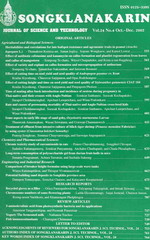ThaiScience
ThaiScience
SONGKLANAKARIN JOURNAL OF SCIENCE & TECHNOLOGY
Volume 42, No. 06, Month NOVEMBER, Year 2020, Pages 1197 - 1206
Short its dna barcode effectively distinguishes the medicinal plants cyclea barbata
Kun Silprasit and Sirikul Thummajitsakul
Abstract Download PDF
Cyclea barbata has been reported as traditional food and medicinal plant. Although its morphology resembles Cissampelos pareira, Cyclea polypetala and Stephania japonica very closely, chemical compositions of them are significantly different. Here we showed the capability of a short ITS region (277 nucleotides) for C. barbata identification. The partial ITS and rbcL regions from 14 samples, collected in many areas of Thailand, were amplified. The results after DNA blast on NCBI showed that all short ITS sequences closely related to C. barbata. The phylogenic analysis from the ITS and combined ITS/rbcL data by maximum parsimony and maximum likelihood methods showed that all samples was recognized into C. barbata. The results of DNA analysis were consistent with morphological identification. Our findings indicated that this short ITS region was able to distinguish C. barbata from their adulterants. This in turn can reduce cost and time for C. barbata identification using DNA barcode.
Keywords
moonseed family, phylogenic tree, DNA barcode, morphology, Cyclea barbataSONGKLANAKARIN JOURNAL OF SCIENCE & TECHNOLOGY
Published by : Prince of Songkla University
Contributions welcome at : http://rdo.psu.ac.th
